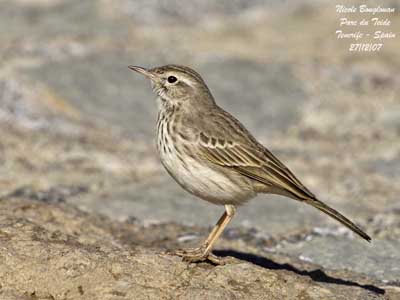
Berthelot’s Pipit - Anthus berthelotii
Passeriforme Order - Motacillidae Family
BIOMETRICS:
Length: 14 cm; Wingspan: 21 à 23 cm; Weight: 16 à 19 gr.
DESCRIPTION:
Berthelot’s Pipit’s name comes from Sabin Berthelot (1794 – 1880) who was resident in Canary Islands during part of his life. He was a French naturalist and ethnologist, and wrote a book “L’Histoire Naturelle des Iles Canaries” with help of Philip Barker Webb in the 1835 – 1850s.
Both adults have dull brownish-grey plumage, providing them an excellent camouflage between rocks and dry vegetation.
Upperparts are mostly brownish with indistinct greyish streaks. Wings and tail feathers are dark brown with buffy edges, broader in flight feathers than in rectrices. Wing coverts with paler edges form buffy-white wing bar.
The tail is mainly brown, with buffy-white external feather on each side and conspicuous buffy-white patch on the tip of the next to the last feather.

The underparts are paler, greyish-white, with brown streaks on breast and flanks.
Head shows brownish-grey crown and nape, slightly streaked with darker brown. We can see a prominent whitish eyebrow. Cheeks and ear coverts are brownish, with darker brown patch behind the eye. Chin and throat are whitish, bordered with fine brown malar stripe.
The thin, pointed bill is flesh-coloured, with blackish culmen and tip. Eyes are dark brown with dark lores, and pale eye-ring. Legs and feet are yellowish. Legs are situated relatively far behind the body, giving the bird particular silhouette.
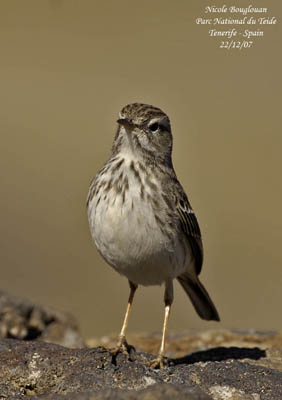
Juvenile is browner than adults, with more contrasted plumage. It has mottled upperparts, due to the feathers showing dark centres and pale fringes. By the first autumn, it acquires the adult plumage.
We can find the subspecies Anthus berthelotii madeirensis, living in Madeira. It has longer bill than Berthelot’s Pipit, but both have similar general appearance.
VOICE: SOUNDS BY XENO-CANTO
Berthelot’s Pipit utters short “chup”, weak “tiuee”, and low “tsik” as typical calls.
Song is given in flight and includes single notes forming phrases such as “tsivrr tsivrr tsivrr tsivrr”. When it is fluttering or during undulating flights, or even from the ground, it gives pleasant series of plaintive notes with variations “tsilee – tsilee…”
HABITAT:
Berthelot’s Pipit is relatively common and found in several types of open habitats such as rocky areas in plains, hillsides with some vegetation, clearings in wooded areas and scrubby slopes. It frequents the open-air restaurants where people give it some crumbs of bread or cake.
It avoids dense forests and wet areas.
Berthelot’s Pipit is resident but it can perform short-distances movements after breeding season.
RANGE:
Berthelot’s Pipit is endemic to Madeira and the Canary Islands where it is common resident. It can be seen from sea-level to high elevation in mountain areas, up to 2000 metres and more.
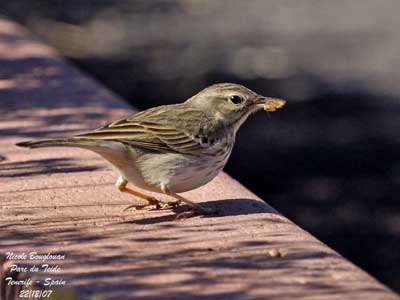
BEHAVIOUR:
Berthelot’s Pipit moves rapidly on the ground rather than to take off if alarmed. It can be compared to a mouse! It walks, and then it stops while it bobs the tail up and down, as a wagtail. This behaviour could serve as signals to other group members and to maintain the unity between these members while foraging. But these signals can also be an alarm or part of courtship displays.
Its streaked dull plumage makes it almost invisible among volcanic rocks. Often seen alone, in pairs or in small family groups, this species rarely forms large flocks. Berthelot’s Pipit is often seen standing upright on held legs.
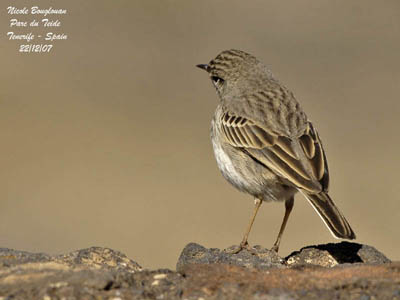
It is fairly tame when it frequents restaurant terraces and parking. It is rarely perched in tree; however, it climbs into bushes and small trees for feeding. It also forages on the ground, searching for insects, invertebrates and seeds. Caterpillars are its main food during nesting period. It may rush forwards in order to catch a moving prey, and can also perform aerial sally for insects.
Berthelot’s Pipit is monogamous.
FLIGHT:
Berthelot’s Pipit performs flight displays while singing, with deep undulations and drawing irregular circles, and then, it drops steeply or in angled glide. It also flutters, but this bird is mainly terrestrial, preferring to run rather than to fly.
REPRODUCTION:
Breeding season occurs relatively early in the year, and the first eggs can be laid in mid-February, but the season also depends on rainfalls and ends in August. It can be later at high elevation.
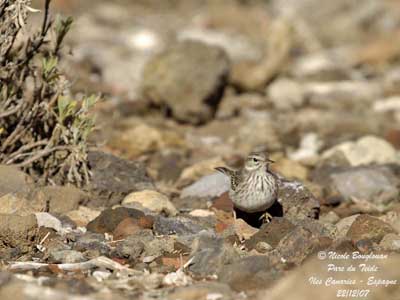
Berthelot’s Pipit nests on the ground, sheltered among tussocks of grasses, small bushes or stones. The nest-site is chosen by female close to or within the main foraging area. Nest is located in a depression with little vegetation, and dry grasses and rootlets are added to build it, and sometimes feathers. The cup is lined with hair and wool or feathers. Male often follows the female while she is building the nest, and it can bring her materials she adds to the cup.
Female lays 2 to 5 eggs, usually 3 or 4. Incubation lasts about 13 days, mainly by female.
Young fledge about 12 to 13 days after hatching, and they are fed with caterpillars during the nesting period. They remain with their parents for one or two weeks, sometimes more.
The main nest failures are due to heavy rains.
This species probably produces two broods per season. Nest is usually reused for the second brood, after renovation of the lining. But a new nest can be built as soon as young have fledged.
DIET:
Berthelot’s Pipit feeds mainly on insects, grasshoppers, crickets, caterpillars, small invertebrates and spiders. It also consumes seeds. It picks preys among rocks and pebbles, and in short grass.
PROTECTION / THREATS / STATUS:
Berthelot’s Pipit is locally common and this species is not threatened. These birds can suffer predation by other birds such as small raptors, and snakes and large lizards.
In spite of the restricted range to Atlantic islands, Berthelot’s Pipit is common in suitable habitat and its populations are stable.
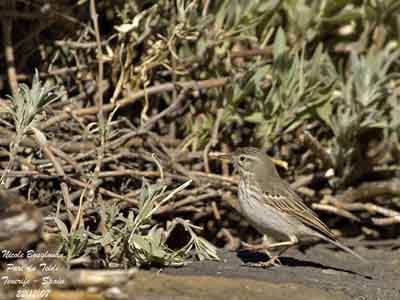
Fr: Pipit de Berthelot
All: Kanarenpieper
Esp: Bisbita Caminero
Ital: Calandro di Berthelot
Nd: Berthelot-pieper
Sd: Kanariepiplärka
Text and photographs by Nicole Bouglouan
Sources:
Personal observations in the fields
HANDBOOK OF THE BIRDS OF THE WORLD Vol 9 - by Josep del Hoyo - Andrew Elliot - David Christie - Lynx Edicions - ISBN: 8487334695
Wikipedia (Wikipedia, The Free Encyclopedia)